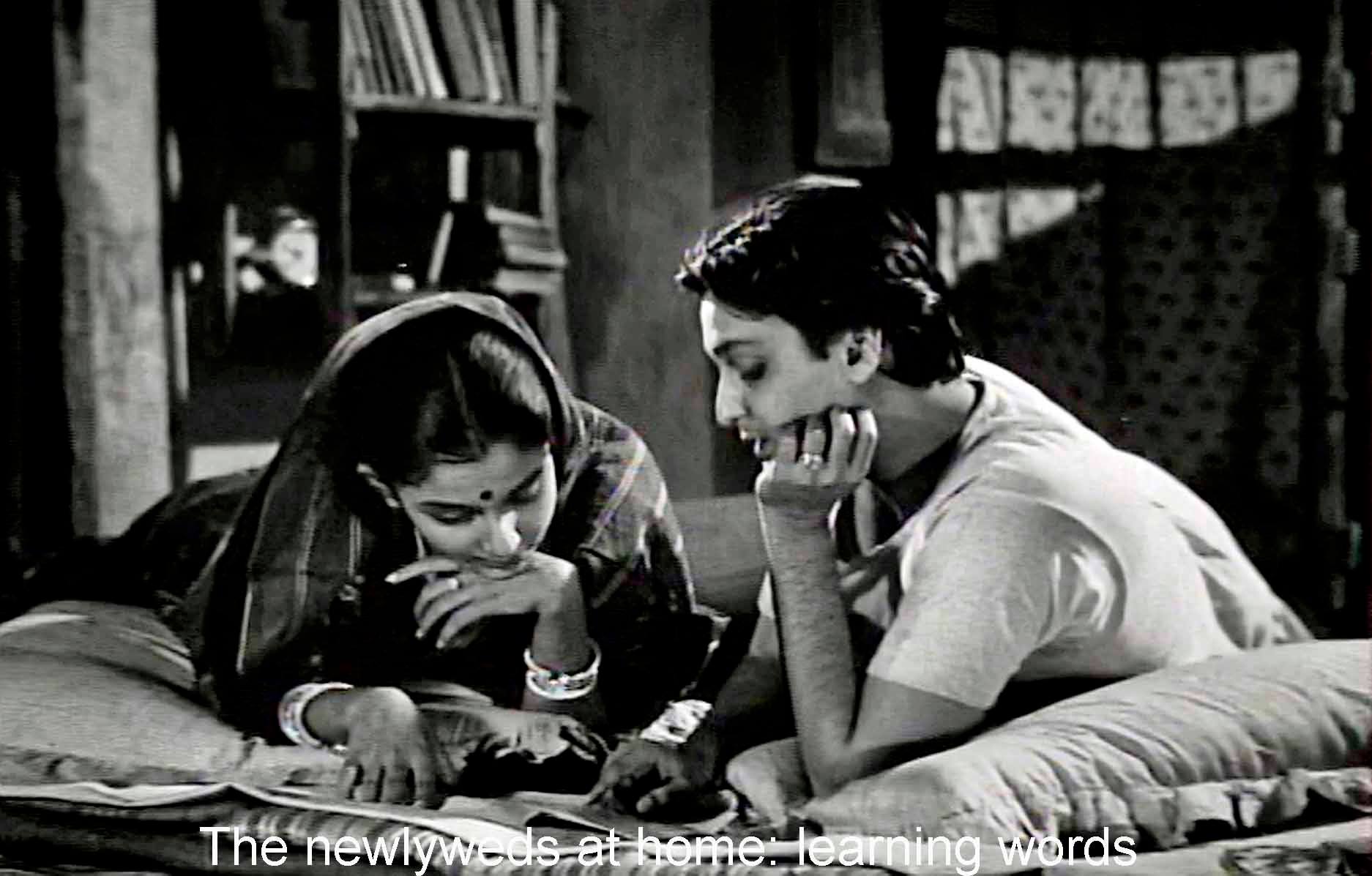The first time I wanted to marry was when I was nine. I attended a maternal uncle’s wedding (one among many in my childhood) and fell in love with my beautiful aunt, my ‘maima’, as she sat decked as a bride – a veritable goddess on earth. I wanted to be that bride-goddess, covered in jewelry, clad in Benarasi, with a crown on my head.
The next time I wanted to be a bride was when I watched ‘Apur Sansar’ for the first time. This had more to do with the handsome groom! I was in middle school then, but don’t remember the exact year. What I do remember is that I’d watched it with Ma, who kept filling in the gaps in Apu’s story even as we watched, as I had seen ‘Pather Panchali’ but not ‘Aparajito’. I wasn’t paying her much attention. There was another bride I’d found arresting, an adolescent one who looked my age. This time, I wasn’t interested in being the bride-goddess; I was totally engrossed in the bride and groom – Apu and Aparna – and their absorption in each other after their wedding. The second half of the film, after Aparna’s death in childbirth, I found very painful and slow and didn’t understand much of. But the first part was seared into my consciousness. And Apu as last-minute groom and Apu as husband stole my heart. There he was, a very good looking young man, asking his bride sensitive questions: how much she knew about him, whether she will be able to cope with poverty, what were her feelings about their strange situation. I had seen some ‘phul sajja’/’suhaag raat’ scenes/songs in films by then, had a vague tingling sensation about them. But this one was different: the bride and groom stood as far away from each other as possible, there was no song, only his anxiousness about an uncertain future and her quiet assurances even as a shy bride.
The twenty minutes of marital bliss that we get in the film was also something I never forgot. It is superfluous to list or describe those scenes – everybody knows them, and enough critics have written about them, too. But the point here is not the cinematic brilliance of those twenty minutes that gives the film its name, but their emotional quotient – the growing intimacy between the newly married couple amidst their domesticity – that even an adolescent like me could relate to.
I saw ‘Charulata’ roughly around the same time, I think – with Soumitra famously playing Amal to Madhabi’s eponymous heroine. The good-looking, aspiring writer/husband was now the good-looking, aspiring writer/brother-in-law. Goes without saying, the “good looking” part was a very important factor in my positive response to the film and his character. Once again, I understood very little of the film – the loneliness of Charu and the complex “extra-marital affair” that happens in its wake, even less of the creative aspiration at the heart of the relationship. But I found Charu beautiful (that was enough as far as she was concerned) and I loved the handsome carefree Amal – singing, writing, flirting by turns (till he disappears), all essential qualities in my idea of a lover.
I got acquainted with Amulya too, not long after. But I found him funny; and ‘Samapti’, for me, was wholly Mrinmoyee’s story, and Aparna Sen as the child bride monopolized my attention as I watched the film. I would see Amulya in a very different light, many years later… but that’s a different story.
Soumitra thus entered my life in my school days. Not a unique story, that; what was, was that I saw him most in a role that he never played on screen – as Amit Ray, of ‘Shesher Kabita’. In the 70 mm of my mind! This is how it began: a Bournvita Quiz Contest question on a Sunday on the novella had Ma summarizing the story for me. The rest of the day was spent reading it, and the next few days translating some favourite passages in my diary. As I read about Amit, Labonya and Ketaki, I could only visualize Soumitra as the hero. I told Ma that. She gave me an indulgent smile. What I didn’t tell was that I had imagined myself as Labonya while reading! I tried imagining an adult version of myself – rather unsuccessfully, I must add. Soumitra was, of course, still the Apu-Amal I’d been smitten by, agelessly handsome. A part of my mind, most irritatingly, couldn’t get rid of the age-difference between us, the fact that the actor was actually my father’s age. But then, who cared? I had Apu-Amal-Amit as my lover. Everything else was irrelevant.
Yesterday, when I learnt of Soumitra’s passing away, unlike most of my peers, I didn’t think of Felu da – the sleuth who was quintessentially a part of my generation’s growing up years & whom the actor immortalized on screen – but these earlier roles of his in Ray films.
In the three decades since my school days, Soumitra the actor had never stopped amazing me. I kept admiring him for new reasons every decade, increasingly with a more critical eye. But it’s the Apu-Amal-Amit of my adolescence that I know I will miss the most. For he defined my very idea of romance and a romantic hero: a man who read and wrote, played the flute and piano, awakened love and aspiration in a woman, was tender and sensitive as a husband, and loved his wife so much that he went mad with grief at her loss. Above all, I will miss my very own Amit Ray!


